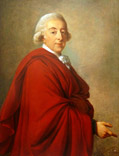 June 5 - August 8, 1982
|
|
| |||
Oil on canvas: 39 3/8 x 30 1/2 inches (100 x 77.5 cm) Signed and dated lower right: Vigee Le Brun a vienne 1793 Private Collection When he died in 1823, Adam Kazimierz Czartoryski was General Starost of Podolia, Field Marshal in the Austrian army, and a Knight of the Order of the Golden Fleece. As head of the powerful Czartoryski clan (descended from the House of Giedymin, the Lithuanian royal family, which through the descendants of Jagiello had ruled Poland, Bohemia, and Hungary from the late fourteenth through most of the sixteenth century), he had helped to govern Poland during one of the most traumatic periods of that country's complex history. Born in 1734 in the city of Gdansk (Danzig), Adam Kazimierz was the son of the Palatine of Ruthenia, Prince Augustus Alexander Czartoryski (1697-1782) and the fabulously wealthy Maria Sophia Sieniawska. His active political career began in 1763 when the Electoral Convocation met in Warsaw to select a successor for the late absentee King Augustus III. Supported by the Cossack troops of Catherine II, the Czartoryskis had him named President of that Assembly. He was officiating in this capacity when his cousin Stanislas Augustus Poniatowski (see cat. no. 47) was forcibly "elected" to the throne. The next twenty years of his life were devoted to literary and pedagogical pursuits. In 1765 he founded a cultural newspaper, the Monitor. Three years later -he assumed the directorship of the newly created military academy in Warsaw and eventually became the Minister of National Education. He wrote a number of plays, mostly comedies in the French manner, as well as treatises on education. In 1781 he was made Marshal of the Supreme Court of Lithuania. Breaking with King Stanislas Augustus, Czartoryski joined the movement which sought to restore his country's independence. His mission to Dresden to engage the Elector of Saxony to accept the hereditary crown of Poland ended in failure (1791). In 1794 while he was in Vienna, uprisings took place in his homeland during which his lands and castles were pillaged. Under Czars Paul I and Alexander I, he enjoyed considerable favor. In June of 1812, Napoleon appointed him Marshal of the Diet of Warsaw, convened in order to organize a confederation against Russia, but by 1813, Poland was again under Czarist control. He retired to Pulawy on the Wisla river and died in 1823 at Sieniawa, the Galician estate he had inherited from his mother. By his wife, nee Countess Flemming (1743-1835), he had several children. His son Adam Jerzy Czartoryski (1770-1861) was Russian Minister of Foreign Affairs under Alexander I, and later, in 1831, presided over the revolutionary provisional government of Warsaw. He died an exile in Paris. Vigee Le Brun had a large Polish clientele. In her list of works painted in Vienna between 1792 and 1795, ten portraits of Polish nobles are included. She recalls having attended in the Austrian capital an important reception given at the home of Princess Czartoryska, whose husband, she remarked, "was very amiable." Souvenirs, II, 227). The work exhibited here is one of two portraits of the Prince, painted by Mme Le Brun when he was fifty-nine. In her inimitable spelling, she calls him "prince Schortorinsky." A poorly preserved full-sized version of the composition, in which the sitter wears a blue cloak, was recently in the Czartoryski collection at the Hotel Lambert, Paris. It also is signed and dated 1793. A small anonymous copy belongs to the National Museum, Warsaw, and another was at one time in the Kazimierz Przbyslowski collection, Lvov. This painting may originally have served as a pendant to Mme Le Brun's portrait of Czartoryski's sister, Princess Isabella Lubomirska, now in the Lvovskaya Galeria, Lvov, Ukrainian S.S.R. (for an illustration, see Ryszkiewicz, 1979, p. 24, fig. 6). Vigee Le Brun also painted a portrait of Adam Kazimierz's daughter, Princess Maria von Wilrtemberg (1765-1854); that portrait, never located, may be related to a miniature reproduced in Grand Duke Nicholas Mikhailovitch, 1905, IV, no. 149. The romantic use of the cloak clutched at the breast was very probably inspired by Jean Laurent Mosnier's portrait of the painter Lagrenee I'aine which Vigee Le Brun had surely seen at the Salon of 1789 (now in the Musee National du Chateau de Versailles). PROVENANCE: Princess Isabella Lubomirska (1733-1816), Vienna and Castle Lancut, Poland; to her daughter, Countess Julie Potocka, Castle Lancut; by descent to Count Alfred Potocki, Lancut and Vaduz; to his brother, Count Jerzy Potocki; Hans. O Schilbeler, Lucerne; sale, Lucerne, Galerie Fischer, November 25, 1965, lot 1577; private collection, London. EXHIBITION: London Heim Gallery, Frencli Portraits in Painiing and Sculpture, summer 1969, no. 37, illus. SELECTED REFERENCES: Souvenirs, 11, 372; Mycielski-Wasylewski, 1927, pp. 35, 42, 91, 133-134, cat. pp. 4-5, no. 8, illus. facing p. 24, pi. 5; A. Ryszkiewicz, 1979, pp. 23-24, illus, p.22, fig. 4.
|
|
Kimbell Art Museum, Fort Worth, Texas.
Web Site Designed and Maintained by |
